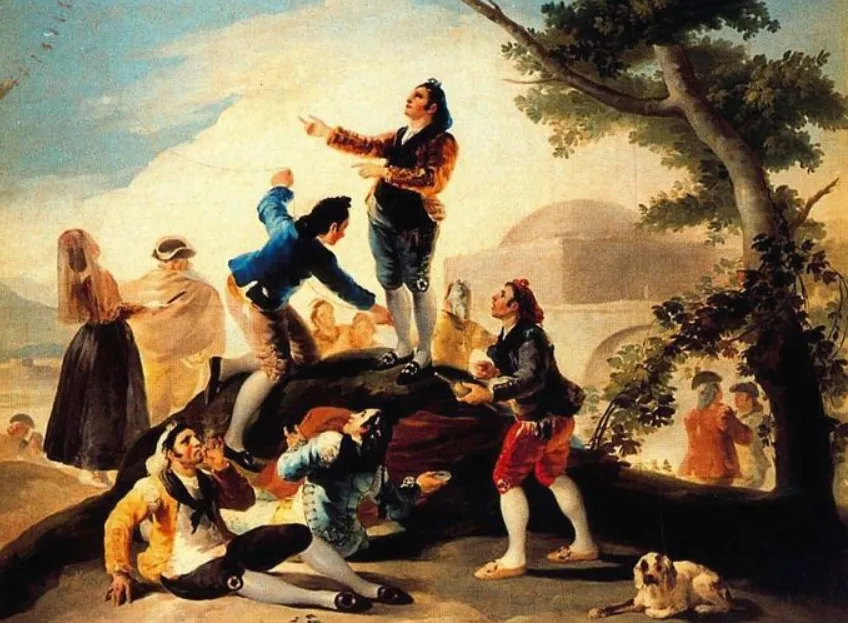From Rococo to Reality: The Evolution of Francisco De Goya’s Artwork

Francisco de Goya, a pivotal figure in the Romantic era, remains one of the most influential painters in Western art history, known for his profound expressions of human suffering and societal introspection. His works range from the elegant and lighthearted tapestry cartoons of his early career to the dark and deeply unsettling Black Paintings of his later years. Among these, “The Dog” stands out as one of Goya’s most hauntingly minimalistic and enigmatic works. This painting is part of the famous Black Paintings series that Goya created on the walls of his house, Quinta del Sordo, near Madrid. Unlike the more overtly terrifying images in the series, “The Dog” depicts a small, half-submerged dog looking up against a vast, overwhelming expanse of a murky, undefined background. With no context and minimal detail, the emotional resonance of the piece comes from its stark depiction of isolation and despair.
Goya’s tenure as a court painter, which began in 1786 under Charles III and continued under his successors, allowed him intimate access to the royal family, shaping his critical eye in portraiture. His role required the creation of flattering images, yet his portraits often revealed more complexity. For example, “Charles IV of Spain and His Family” not only displays the regal pomp but also subtly hints at the superficiality and perceived incompetence of the royals. This tension between his role and his personal insights into the character of his subjects gave his royal portraits a unique depth, challenging the norms of court painting.
The transition in Goya’s work from public to deeply personal is most evident during his late period, which was marked by a severe illness that left him deaf in 1793. This physical and emotional isolation profoundly influenced his artistic vision, leading to more introspective and sometimes nightmarish works. The shift is evident in his “Pinturas Negras” where the tone becomes significantly darker and more reflective of his inner turmoil and disillusionment with the sociopolitical climate of Spain, particularly after the Peninsular War.
Moreover, Francisco De Goya’s “The Dog” artwork is notable for their radical departure from his earlier, more detailed, and colorful style to a stark minimalism that emphasizes mood over form. This piece, with its vast empty space and the small, forlorn figure of the dog, can be interpreted as a metaphor for man’s struggle against overwhelming forces of nature or society—a theme that resonates with modern existential thought. The simplicity and ambiguity of “The Dog” invite multiple interpretations, making it one of the most compelling and discussed works in Goya’s oeuvre.
Goya’s career was marked by his keen observation and critical perspective on Spanish society. His earlier works, such as “The Parasol” and “The Swing,” reflect a lighter, Rococo-influenced style, full of vibrant colors and dynamic scenes of leisure and pastoral life. However, as his career progressed, Goya’s work took a darker turn, particularly with his “Caprichos” series, a set of prints that satirized the universal follies and foolishness of Spanish society. The “Disasters of War” series, created in response to the brutal Peninsular War, showcased Goya’s grim realism and his ability to convey raw human emotion and the horrors of war through stark, impactful images.
In his royal portraits, Goya did not shy away from depicting the flaws and personalities of his subjects, as seen in his unflinchingly honest depictions of King Charles IV and his family. These portraits often subtly critiqued the excesses and corruption of the royal court by focusing on personal traits and unidealized representations. Goya’s ability to communicate a deeper truth through these portraits altered the way royalty was traditionally portrayed in art.
The latter part of Goya’s life was marked by a growing disillusionment which culminated in the Black Paintings, created between 1819 and 1823. These works were painted directly onto the walls of his home and later transferred to canvas. They are somber and often macabre, reflecting his pessimism towards humanity and his struggle with his own mental health. Paintings such as “Saturn Devouring His Son” and “Witches’ Sabbath” display a raw, visceral approach to mythological and fantastical subjects, conveying a sense of dread and despair that was revolutionary at the time.
Through his extensive and varied body of work, Goya left a lasting legacy on both the Romantic movement and modern art. His techniques and thematic choices continue to influence artists, and his works remain highly regarded for their powerful emotional depth and their bold critique of societal norms. Goya’s fearless exploration of personal and collective trauma, coupled with his innovative use of form and shadow, cemented his status as a pivotal figure in the art world, bridging the gap between the Old Masters and the modern painters who would follow in his footsteps.


